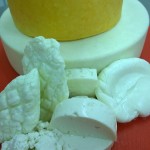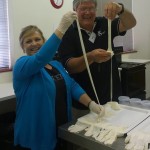Category Archives: Cheese making
Cheese Making Course using our rennet
You can now buy rennet directly from the online shop in South Africa!
Hi, Cheese Making Fans
Buy Rennet
directly from the online shop in South Africa at:
http://cheesemaking.co.za/shop/10-rennet-south-africa

Regards,
Leon
http://www.answers.com/Q/Where_can_you_buy_rennet_tablets_in_south_Africa
Rennet Suppliers South Africa – Buy Rennet
Rennet for Slow Food Cheese
http://slowfoodcapetown.co.za/suppliers/cheese/rennet/
In cheese making we do get an acid set in some cheeses, but this is not always convenient or desirable and some cheese do require earlier coagulation, like sweet milk cheeses for example.
Rennet is a curdling agent and enzyme that acts on the milk protein casein, causing separation of the milk into solid curds and liquid whey.
Some soft acid set cheese, for example, need a very small amount of rennet with an long, extended setting time for acid formation from the cultures as well, otherwise they will go rubbery. This then also means that the longer the ripening time with the culture, and thus the more acid has formed, the shorter the setting time. So rennet is a stomach enzyme and thus performs much better in an acid environment.
Several proteinases will coagulate milk under suitable conditions of pH, temperature, dosage, available calcium and protein, etc., but a lot of them are just too proteolytic according to their milk clotting activity. In most cheeses the main job of rennet is to coagulate the milk, so that it can be cut and drained from most of its moisture to preserve it. After that we do not really want the proteolytic – protein breakdown – to continue. Too much proteolytic activity from the curdling enzyme can cause defects, like bitterness in the cheese, as well as texture faults.
Animal rennet or chymosin is prepared by extracting the dried and/or salted gastric tissue with 10% sodium chloride and activating and sterilising the extract. Usually we find that as the animal ages the more pepsin and the less rennet/chymosin is in the stomach. So rennet from a young calf can be 96% chymosin, but from an older animal can be 20% or even less chymosin.
So although some plant proteinases, like fig juice, nettle extract and paw-paw juice has been used for some cheeses in some cultures, it is predominantly rennet from animals that have been used.
In recent decades these animal based rennets have been substituted to a large degree with microbial rennets from GMO and non-GMO origins. GMO sources resemble animal rennet exactly as can be expected, but the non-GMO microbial rennet does not actually structurally or chemically resemble actual rennet or chymosin – it is just another enzyme with the ability to curdle milk.
Rennet gelation of milk involves the conversion of milk from a colloidal dispersion of stable micelles to a network of aggregated paracasein micelles in a continuous phase entrapping fat and moisture in its pores.
Rennet – Cape Town – Johannesburg, Gauteng – South Africa
Cheese making course – June 2014
Hi, Cheese fans
Our next cheese making course is coming up in Stellenbosch on 26,27 June 2014.
Please mail Elaine for info at elaine@alivingway.com.
See you there,
Leon
Antibiotics does not affect the setting of milk with rennet
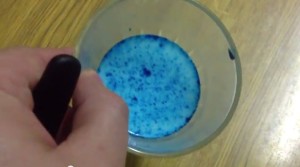
Check the video by clicking the link underneath:
Rennet does set milk – even if it is loaded with antibiotics
The same of course does not hold true for cultures used in cheese making, since they are bacteria as well – so the antibiotics will kill the good bacteria as well. Rennet is an enzyme, so not affected by antibiotics. The reason the milk is blue in the video, is because I used antibiotics used to treat udder infection in cows, so the antibiotic is dyed to see if it is still in the milk.
Buy rennet in South Africa from www.cheesemaking.co.za
Rennet types – know them all today
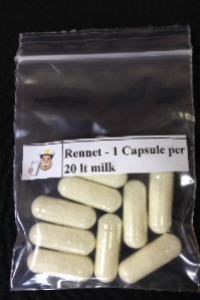
Hi, Milk Fans
The different rennet types or milk coagulation enzymes are:
- Rennet from animal origin
- Rennet from GMO micro-organisms
- Curdling enzymes from plants
- Curdling enzymes from Non-GMO micro-organisms
Rennet from animal origin is the “mother” of rennets giving the highest yield and best taste.
Microbial rennet types from GMO micro-organisms has the same chemical composition as animal rennet, with some side reactions, but very close. The comparison is basically like artificial vitamin C and natural vitamin C.
The curdling enzyme rennet types from plants like, figs, papaya, etc. are suitable for lacto-vegetarians.
Curdling enzymes from Non-GMO organisms are generally, Kosher, Halaal, vegetarian.
South Africa
More about Rennet
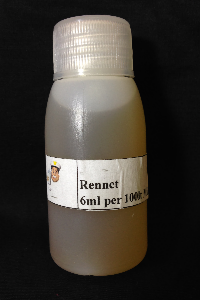
Rennet is used in the production of cheese as a milk curdling enzyme. It converts milk casein (protein) from a soluble to an insoluble material and during this process; it separates the milk into solids (curds) and liquid (whey).
The different milk coagulation systems available is natural animal rennet, also from GMO organisms, coagulating enzymes from plant origin and coagulating enzymes from non-GMO microbial origin.
Animal rennet is the best
A lot of people prefer not to use it, because of religious views. The closest product is rennet from GMO origin, since chemically it is just like rennet of natural, animal origin, but here we also have a protesting fraction of people, because they believe this type of product will harm them in some way. They thus do not perceive this as “natural”.
Plant coagulation enzymes are not used commercially, since they are very hard to standardize and usually have a lot of side reactions that can cause off-tastes and other problems in cheese.
Microbial rennet of non-GMO origin has vastly improved and now has very few side- reactions. This rennet is used in large amounts in the world, since it is classified as Halal, Kosher and vegetarian. Technically these are not rennet, but milk coagulating enzyme. Different organisms are used to produce non-GMO microbial rennet.
Microbial rennet is a food grade enzyme system produced by the controlled fermentation for non-genetically modified Rhizomucor miehei . It contains the specific protease activity that makes it effective as a milk clotting enzyme. The rennet have been specially treated to make the enzyme thermal labile sensitive to inactivation by heat at pasteurization temperatures. Rennet can be bought in tablets and as liquid or paste.
As the economical alternative to cloned/ calf rennet, microbial rennet liquid has the same uses, process conditions and clotting time.
When buying rennet, certain characteristics need to be taken into account. This will include activity of 1:50,000 MCU/ml, form which should be a dark brown liquid, solubility (miscible with water), odorless and a specific gravity of approximately 1.14g/ml.
Rennet requires the availability of calcium ions for activity. Calcium, added as calcium chloride should be in the range of 10 to 100 grams per 100 litres of milk for optimum performance. The effect of calcium chloride concentrates on the activity of various enzyme samples and is superior to animal rennet.
Enzyme use levels are generally dictated by processing conditions, milk composition and calcium chloride concentration. In a general a rate of one half that of regular strength calf rennet can be used, but laboratory or pilot scale tests should be run to optimize dose levels.
Effective working temperature range plays a big role in performance. Calf rennet has a much narrower range of optimum working than most of the new “rennet” systems.
Due to rennet’s thermal labile nature, extra care should be taken when storing rennet; therefore it should be stored in sealed containers under refrigerated (4?C to 8?C) to minimize the loss of activity.
When using rennet to coagulate milk, always make sure to check the specification sheet of the product that you plan to use, to make sure that you are using it in the rifgt way to get the most out of that specific product.
Article from www.LeontheMilkman.com
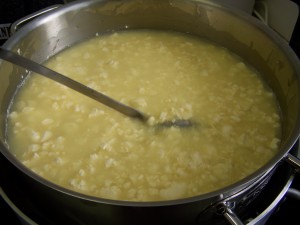
Rennet Suppliers South Africa
